Orthodoxwiki
 Our Venerable and God-bearing Father David of Euboea, also David the Elder ((Greek): Ὁ Ὅσιος Δαβὶδ ὁ ἐν Εὐβοίᾳ), ca.1480 - ca.1589, is a Saint and Wonderworker of Ottoman Greece. His feast day is celebrated by the Orthodox Church on November 1.
Our Venerable and God-bearing Father David of Euboea, also David the Elder ((Greek): Ὁ Ὅσιος Δαβὶδ ὁ ἐν Εὐβοίᾳ), ca.1480 - ca.1589, is a Saint and Wonderworker of Ottoman Greece. His feast day is celebrated by the Orthodox Church on November 1.
The Monastery of Saint David in Euboea, which is dedicated to the Transfiguration of the Savior, and yet is associated with Saint David who founded it about 1535-1540 AD and lived his monastic life there in the 16th century, celebrates on August 6th as well as on November 1st. Within the church are the relics of Saint David, his censer, his priestly stole, and other treasures.
Biography
Early Life
Saint David was born between 1470 and 1480, in the village of Gardinitsa in the province of Locrida. The name of this village today is Kyparissi. His father, Christodoulos, was a priest. He and his pious wife Theodora had four children, whom they raised "in the nurture and admonition of the Lord".
St. David of Euboea as a child before the icon of St. John the Forerunner.
On the sixth day, which was Saturday, David's father went with some villagers to that chapel to serve the Vespers and pray to the Saint for his child. When they arrived, they were surprised to see little David on his knees in front of the icon of Saint John. His face was glowing with a celestial light and he didn't look at all haggard. Then they all understood that this child was not like the other children, he was special.
Holy Orders
When Saint David was fifteen years old, he left his village with the blessing of his parents and followed the Hieromonk Akakios, a virtuous and experienced spiritual father, whom he met due to the Providence of the Lord. In the monastery of Elder Akakios, Saint David lived as member of the brotherhood for five years.
His asceticism, obedience and humility were sterling. The prudence and the wisdom of the young novice were the reason his brothers in the monastery called him "David the Elder".
Following Akakios, who had the desire to meet virtuous monks, they left the monastery and visited a lot of other monasteries and retreats. In a monastery in Ossa, where they stayed for a long time, Saint David was ordained Deacon.
Their next destination was Mount Athos. After worshiping in the Holy Monasteries and meeting the holy ascetics, Elder Akakios left for Constantinople to receive the blessing of the Patriarch, while Saint David remained at the Great Lavra of Saint Athanasios the Athonite. The Patriarch not only blessed Elder Akakios, but also convened a Synod and ordained him Metropolitan of the Holy Diocese of Nafpaktos and Arta. Akakios took Saint David with him to the Diocese, where he ordained him a priest.
The obedience of Saint David to the Elder, his spiritual father, was great. The following incident depicts this obedience in the most vivid way. One day Elder Akakios sent David from Nafpaktos to Arta for some work. It was a journey of four days by foot. Saint David was walking barefoot, as was usual for him, through difficult and wild paths. When he arrived outside the city of Arta, he stopped for a while to rest. A charitable Christian saw him and immediately bought a pair of tsarouhia (traditional Greek footwear) and gave them to the fatigued monk. The humble Saint David, who did not want to offend this kind and devout man, accepted and wore them. After finishing the work that the Elder had assigned to him, the Saint returned to Nafpaktos. When the Bishop saw him wearing new shoes, he reprimanded him for accepting the offer of the Christian without first having received his blessing. He ordered Saint David to remove the shoes from his feet and return them to the person who gave them to him. Saint David, obeying his Elder, returned barefoot to Arta, found the Christian, and after giving him back the tsarouhia, returned once again to Nafpaktos.
Hegumen of Varnakova
The goodness of Saint David and his spiritual progress were obvious to everybody. The Bishop and the lords of the area kindly requested, and finally persuaded, the Saint to become the Hegumen of the Monastery of the Holy Mother of God in Varnakova. This position was difficult, because he had to deal all the time with the problems caused by the restive monks of the monastery.
St. David teaching Orthodoxy and Hellenism to children in the "Secret School".
As the Hegumen of Varnakova, he established the first Greek school, where very important learned priests from Mount Athos were teaching, as well as a "Secret School" in the Monastery, which was operating up to last century.
However, the problems caused by the fathers of the Monastery continued to exist. Because of the inappropriate behavior of some monks, who despite his advice did not reform, Saint David decided, reluctantly, to leave the Monastery.
At Mount Steiris
St. David being tortured and imprisoned.
Nevertheless, the hateful devil found and took the opportunity to attack the Saint once more. He was accused by local people as the one responsible for the escape of some slaves of a Hagarene lord from Livadia. For this reason, they arrested Saint David, imprisoned him and tortured him brutally. Saint David suffered everything with patience. However, by the Providence of the Lord, some devout Christians appeared and paid the money to release the Saint. When the Saint was released, he thought that it would not be good to return to his monastery. After some time, which he spent wandering in that area, without being able to find an appropriate place to rest, he decided to go to the island opposite, that is Euboea.
At Euboea
St. David miraculously crossing over the waters to the island of Euboea.
With his robe he arrived at the village of Rovies. When he stepped on the shore, he began climbing the green mountain, which rose behind the village. He found there the almost ruined chapel of the Transfiguration of Jesus Christ our Savior, which he totally reconstructed, assisted by the local people.
The holiness of Saint David was a powerful magnet attracting people who wanted to dedicate themselves to Jesus Christ. As a result, a small brotherhood quickly formed. The cells, built to cover the needs of the brotherhood near the chapel, were not enough.
Trip to Russia
Saint David decided to travel to faraway Russia to collect the money needed to build a new monastery. After surveying the area, he chose an appropriate high place on the mountain and, before leaving for his journey, gave instructions regarding the construction work to the craftsmen and artisans.
Saint David, assisted by the Greek community in Russia, which was flourishing during those years, collected a great amount of money. However, he was aware of the difficulties and the dangers of the long return journey. So he decided not to take the money with him, but to transfer it to the island by a different route. He took a piece of wood, hollowed it out, and put all the money in it. Then he sealed the opening, made the Sign of the Cross over it, and threw it into one of the rivers of Russia, while he began his return journey alone.
Monastery of Saint David at Euboea
St. David of Euboea putting the treasure into the log (top), and it being miraculously preserved (bottom).
When Saint David arrived at the monastery, he saw that the craftsmen had not observed his instructions and instead of building the new monastery on the top of the mountain, they had started building it near the chapel of the Transfiguration. Saint David became upset. He asked them why they had disobeyed and they answered that on the top of the mountain, where he wanted the new monastery to be built, there was no water.
St. David of Euboea and the miraculous spring of holy water.
However, for reasons known only to the Lord, the Saint allowed the craftsmen to continue the construction at the point where the monastery has stood up to the present day. The monastery was founded circa 1535-1540 AD. As for the water that still flows powerfully today, in 1963, some fellow-countrymen of the Saint created a channel to bring it into the yard of the monastery.
The natural gifts and the holiness of Saint David had become widely known. Many Metropolitans invited him to their dioceses for the spiritual benefit of the Christians.
Once, the lords and bishops of the Peloponnese invited him to resolve the problems and the divisions between them. Saint David began his journey with love and eagerness. Although the ship on which he was traveling encountered heavy seas and was wrecked, Saint David was rescued through a miracle and nine hours after the shipwreck the accompanying monks saw him floating on the sea, unscathed.
At one time, Saint David was going to Karystos on some business of the Monastery. On the road, he stopped at the village of Disto to rest himself. There, the residents of the village asked the Saint to release them from the swarm of mosquitoes, from which they were suffering. The Saint seeing their devotion, prayed fervently to the Lord and then a great miracle happened. Mosquito clouds started to fall and disappear into the sea, in front of the surprised eyes of the locals.
Another time, the Saint was in Elefsina for the spiritual benefit of the Christians. There, he was guest in the house of a devout Christian. The master of the house, so as to please the Saint, cooked among other dishes, a pumpkin, which at the time, was a newly introduced garden vegetable. But when they tasted the pumpkin they found that it was really bitter. The master of the house felt really bad. The Saint realised it, prayed secretly, and as a result the pumpkin became sweet and tasty.
The monastery became a beacon for the area of North Euboea which illumined the people's souls and comforted the Christians during those difficult years of slavery.
Saint David was distressed and hurt to see the poverty and misery of the people who came to the door of the monastery. He cared first for the spiritual welfare of the pilgrims and then for their material needs. The believers called the monastery "The Monastery of Charity".
Later Life and Departure
The righteous dormition of St. David of Euboea.
When Saint David grew old he appointed another hegumen and withdrew to his retreat, which was a tiny cave formed by a complex of rocks in the forest. He stayed there in prayer during the whole week, eating only a piece of Antidoron and drinking only some holy water.
On Saturday afternoons Saint David would come to the monastery. On Sunday morning he served the Holy Liturgy, received Holy Communion and after advising and comforting the pilgrims to the Monastery, and educating and supporting the monks, he would leave late in the afternoon for his retreat.
The wonderworking Skull of St. David, treasured by his monastery in Euboea.
The miracles of Saint David have been numerous during the centuries, as have been the believers, who have become witnesses of his glory before the Lord's throne. People with physical, psychic and spiritual diseases are freed from the burden of their ailments by leaning down to venerate his holy skull. They depart healed and they thank the Saint, praising God.
We commemorate him on November 1st.
May we all have his blessing!
Sources
- Holy Monastery of Saint David the Elder. SAINT DAVID OF EUBOEA. A BRIEF BIOGRAPHY. ΑΠΑΝΤΑ ΟΡΘΟΔΟΞΙΑΣ. 28 July 2011.
- Great Synaxaristes: (Greek)Ὁ Ὅσιος Δαβὶδ ὁ ἐν Εὐβοίᾳ. 1 Νοεμβρίου. ΜΕΓΑΣ ΣΥΝΑΞΑΡΙΣΤΗΣ.
- November 1/14. Orthodox Calendar (Pravoslavie.ru).
External Links
- Monastery Osios David, Evia island, Greece. Flickr. (Photos)
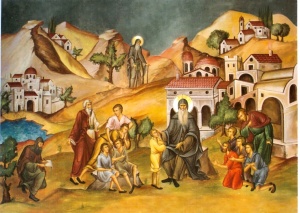
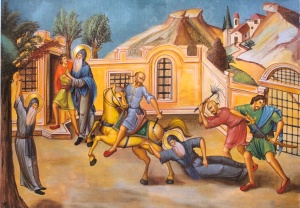
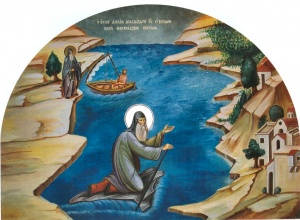
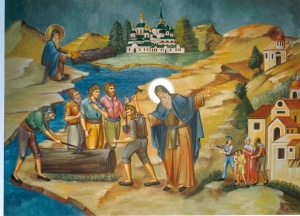
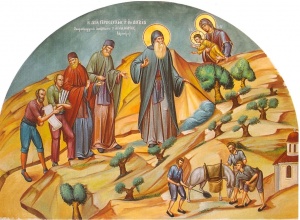
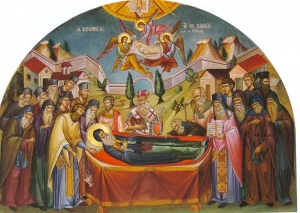
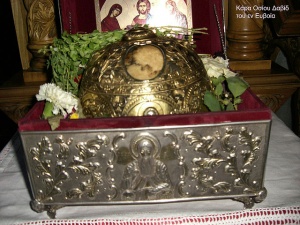
Δεν υπάρχουν σχόλια:
Δημοσίευση σχολίου